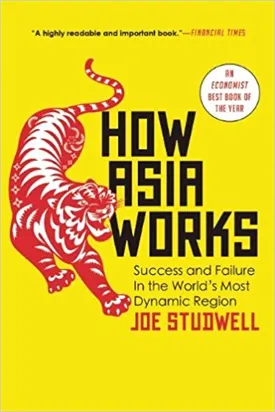Joe Studwell’s book “How Asia Works” is at once a fascinating look into the complex economies of East and Southeast Asia and a cautionary tale to western countries that have yet to make it economically. In the book, Studwell takes the reader on a journey through the economies of Asian countries like Japan, China, Korea, Indonesia, and the Philippines, among others. He details specific political and economic policies used by different countries to achieve varying rates of economic success and examines the successes and failures of their approaches. In doing so, Studwell challenges western conceptions of economic development, explains the causes and consequences of east Asian successes, and makes a call for western countries to look to Asian countries for inspiration.
The book begins with a history of the region, beginning in World War II. Studwell explains how Japan, having been defeated in the war, began an ambitious journey to become an economic powerhouse. Japan was able to create rapid and sustained economic growth by focusing on capital-intensive industries, encouraging savings and investment, setting long-term targets, and relying on a highly educated and disciplined workforce. Through this approach, Japan achieved previously unimaginable levels of economic growth, transitioning from an impoverished nation to the world’s second-largest economy.
Studwell goes on to examine how other countries have taken Japan’s strategy and applied it to their own settings with varying results. He points out that while Japan was able to rely on an inherently disciplined population and culture, other countries had to implement authoritarian policies in order to achieve the same level of success. He specifically focuses on China and explains how the Chinese Communist Party (CCP) was able to take Japan’s model and add an extra element of coercion that enabled them to achieve unparalleled economic success.
Studwell also examines the economic development of Southeast Asian countries such as Malaysia and Singapore. He explains how these countries were able to achieve strong economic growth by following the same principles of capital-intensive industries, savings and investment, and long-term planning as other countries in the region. In addition, countries like Malaysia and Singapore relied on cheap labor, sheltered their economies from foreign competition, and created long-term fiscal and monetary policies, all of which contributed to their successes.
While How Asia Works is an impressive examination of complex economic issues in Asia, it is also a call to arms to western countries, who have lagged far behind their eastern counterparts in terms of economic growth. Studwell makes a strong case that western nations should learn from the successes of east Asia and implement policies similar to those of countries like Japan and China, all while recognizing the dark sides of their authoritarian models. He believes that if western countries focus on the same principles of long-term planning, capital-intensive industries, and savings and investment that have been the keys to east Asian successes, they too can create conditions for rapid and sustained economic growth.
In How Asia Works, Studwell has created a highly informative book that sheds light on the successes and failures of Asian economics. Through a careful examination of specific countries, he provides a solid understanding of the varied approaches towards economic development in the region and makes a compelling case that the lessons of east Asia should be applied by the west.

